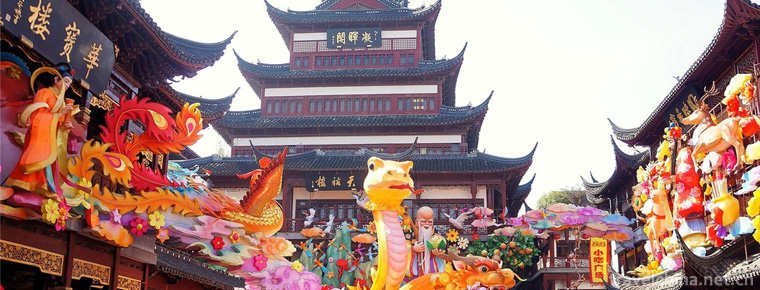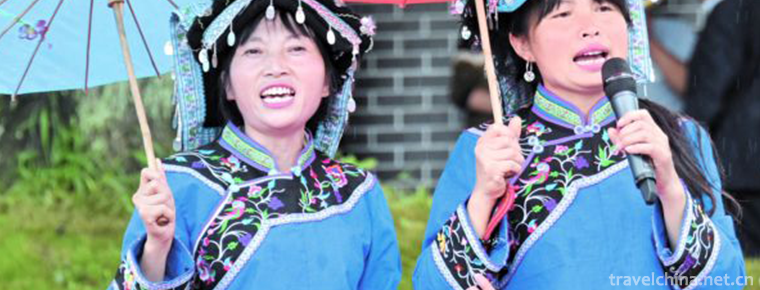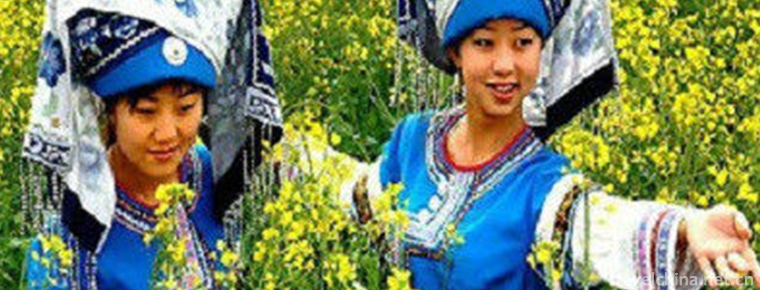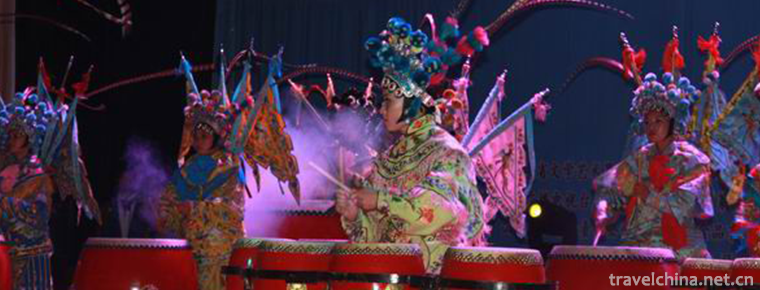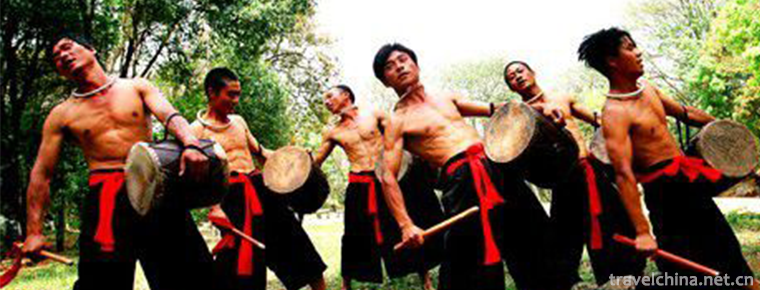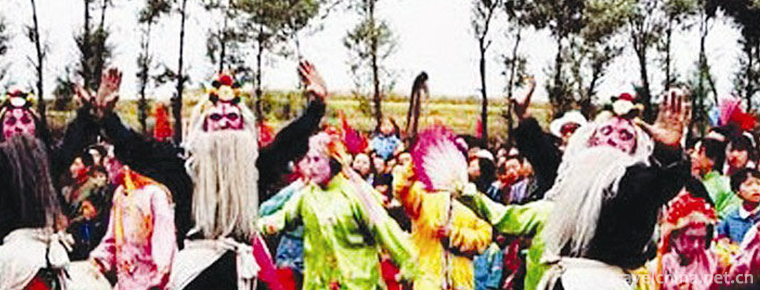Nanxi chant
Nanxi chant
Nanxi chant is popular in Qianjiang District of Chongqing City. Its origin can be traced back to Tang Dynasty. Its embryonic form is Tujia peasants'work chant and folk song chant, which are similar to the grass Gong and drum. Generally, there are no less than seven people shouting, one leading singer, two or three dressing up as high-pitched voices, others singing bass, and all the people help to tune.
In 2006, Nanxi Nuozi was listed in the national intangible cultural heritage list.
historical origin
Popular History
Nanxi chant is popular in Qianjiang District of Chongqing. Its embryonic form is Tujia peasants'laboring chant and folk song chant, which are similar to grass Gong and drum. In the long process of singing, Nanxi chant has gradually developed into a special folk song variety of its own style. It is different from the surrounding chant of Chuanjiang River and the chant of tracker, as well as other labor chant and folk song chants widely sung in Wuling Mountain Area.
Nanxi chant lyrics are mostly improvised, but its tune and singing method are relatively fixed. There are more than ten kinds of singing tunes, such as big board tunes, nine turnings, three sets of voices, loudspeakers, Nanhe horns and so on. Its basic singing method is one person leading, two or three people acting as shrill (that is, shouting loud), three or more people shouting bass, and many people supporting the voice, thus forming a high and low voice corresponding to each other and melodious and agitating sounds of nature in the mountains.
Historical Contents
The content of Nanxi chant involves Tujia history, geography and folklore, conveying a lot of ancient historical and cultural information. It is a relic of Tujia music culture, with high artistic value, while enriching the cultural life of the people, serving the spiritual civilization construction of contemporary society.
Nowadays, fewer than ten people can sing Nanxi chant in the whole Qianjiang district, and they are all old enough. None of the young and middle-aged people can sing chant. This folk music style is in serious danger and needs urgent rescue and protection.
Nanxi chant is popular in Qianjiang District of Chongqing City. Its origin dates back to the Tang Dynasty. Its embryonic form is the work chant and folk song chant of Tujia peasants who lost their energy in their labor.
Nanxi chant is popular among the Tujia and Miao people in the mountains, valleys and deep valleys of Qianjiang District. It is sung in chorus with high tone and grandeur. Singing regardless of the occasion, location, the local people are fond of red and white happy events.
Nanxi Village has the saying of "ten couples of men and women, nine couples of songs, ten folk songs and nine love songs". People who love to sing folk songs sing whatever they see or think, often a folk song begins to be sung by one person. People like it and naturally it will be sung in the crowd.
The tune and singing method of Nanxi Chant are relatively fixed. Its basic singing method is one person leading, two or three people singing tenor, three or more people singing bass, and many people singing together, thus forming a high and low voice corresponding to each other and melodious and agitating sounds in the mountains. In 2006, Nanxi Nuozi was listed in the first national intangible cultural heritage list.
At the beginning of the new year, the cultural circles in Qianjiang District of Chongqing have spread great news: the famous "Qianjiang Nanxi Chant" has been selected into the first national list of intangible cultural heritage recommendation.
The villages inhabited by Tujia and Miao nationalities in southeastern Chongqing can be regarded as the sea of folk songs. Nanxi of Echi Town, Qianjiang District, is a famous town of folk songs. It is known as "the two sides of Nanxi, men, women, old and young can sing". Here, the national culture is rich in resources, rich in cultural connotations and distinctive features. Nanxi Folk Songs, represented by Dabanqiang, Jiudaojiao and Santaisheng, are everywhere and everywhere. The rugged "Nanxi Chant" exudes a strong flavor of life and has a strong artistic appeal. It has won prizes in the whole country.
It is reported that the first batch of national intangible cultural heritage selection, according to the category of declared items, is divided into ten categories: folk literature, music, acrobatics and skills, folk customs and so on. Chongqing has sent 25 folk arts for declaration. In the first 501 publications on the list of the first national intangible cultural heritage lists, Nanxi Channel of Qianjiang River was listed with 10 items, such as Tongliang Dragon Dance, Chuanjiang Channel, Liangshan Lantern Opera and Liangping Wood Engraving New Year Picture.
Detailed introduction
It is hard to imagine the magnificent tone of the chant itself and the melancholy and moving "absolute" of the folk songs without listening to it personally. Nanxi chant was born in the work and life of Tujia villagers, which has echoed in the deep mountains and gorges for thousands of years. However, with the dramatic changes in social life in recent decades, few people have learned to sing, which is really on the verge of extinction. A few days ago, the reporter interviewed on the spot and confirmed by many local cadres and villagers that Qu Index can really reproduce the original ecological status of the song at present, only more than ten elderly people, the youngest 52 years old and the oldest 78 years old. Listening to their chorus on the spot, we can really feel the solemn and solemn meaning of "absolute singing"...
I come from a deep valley stream
"The Heron died on the ridge of the field, and the white crane came together to cry for a while. Although it was not the same bird in the woods, everyone was a fisherman..."
On the evening of September 25, 2011, when Feng Guangxiang, a 60-year-old Tujia woman, sang the song "Suona Tune", she was immersed in a sad mood, humming to the depths and bursting into tears.
The Tujia folk singers from Nanxi Village, Echi Town, were seen in the Mass Square of Qianjiang District. They came to attend the first rural culture festival in Qianjiang District. Xie Tingwen, Deputy Secretary of Echi Town, who led the team, said that Nanxi chant was only sung in Nanxi village at present, and there was no such folk song type around it for a long time.
Yang Zaifang, 78, said: "Nanxi Village is 100 kilometers away from here (Qianjiang District Government). There are more than 400 households in the village. Now young and middle-aged people go out to work, and younger women follow suit. The only people left home were the elderly and the children studying."
Speaking of the roar, the old man was quite excited. "It's something passed down from his ancestors. You can't roar at people, you need more people to do it." One leader, many people and work together to relieve the lack of energy. Reporters learned that the origin of Nanxi's chant dates back to the Tang Dynasty. The embryonic form is produced by the folk song chant in Tujia people's labor, which is similar to the "grass Gong and drum" around it. The chant is usually no less than 7 people. "One lead singer, two or three play the shrill (high) voice, the others sing the bass, and all the people help the tune."
The 68-year-old Hu Anlu said that their Tujia village was situated in a deep valley between two high mountains. The Nanxi River flowed through and through Youyang into the Apeng River, a tributary of the Wujiang River. He also remembered that in the 1950s and 1960s, it was during the period of collectivization and communalization in the countryside that the people working on the slopes sang the trumpet. The two sides of the Straits were in harmony with each other, and their voice was magnificent. It was really the voice of heaven that echoed in the mountains and fields.
Don't climb elegance to be interesting
Yang Zhengze, 58, is a young singer in the singing team. He talks about the tune of the trumpet like several jewels: the trumpet.
Dabanqiang, Jiudaojiao, Nanhe, Santai Sound, Riot Platform... From the content point of view, in addition to the emotional wisdom and humorous optimistic nature of Tujia people accumulated from labor and life, it also involves a lot of history, geography, Tujia folk culture and folklore.
"On both sides of Nanxi Mountain, men and women, old and young love to sing, and chants are raised along both sides of the river,'explosion'breaks the Younan River..." The 61-year-old Hu Xingze and 64-year-old Ruan Ying-ying are more interested in talking about the love songs in the chant.
"When the sun comes out to bask in the white rock, the lover comes out to"bask in the cough"(yawn);
I don't love my lover's cough, I love her good talent...................................................
Old people, you say a word and I say a few words to the reporter to start the lyrics. For example, the chorus of June Grass:
(Man): The June sun is like a fire. You lend me your cool hat.
Nanxi chant
(Woman): You want a cool hat. You take it. The June sun doesn't shine on me.
(Male): The handle of a weeding hoe is long, and the straw cap of wheat roots covers the sun.
(Woman): As long as you like me, I'll weed and you rest in the cool.................................................
It is these touching songs that accompany the memory of these Tujia old people and protect their vicissitudes of life.
Where can the wind break?
Yang Zaifang said that when he was in his 10s working on the uphill slope, he began to roar. The slogan should not be taught by others. As long as it is integrated into the working population, it can not help but pass on word of mouth and vent it.
Feng Guangxiang often acts as a "collar voice" nowadays. She said that she loved singing when she was young, especially chanting. But her grandparents forbade her to learn it. According to Tujia's rules, women were forbidden to roar before they got married. So she quietly followed the adults humming, over the decades, but also accumulated a belly of chants. She said that her feelings could not be separated from chants, and her culture was also taught by chants, such as the common sense of folklore and geography in chants:
Ask, step down the hoe to root, which state and county does the steel come from? Which state was the blacksmith born in?
Sing a song, let me help you to explain why, steel comes from Qingzhou County, blacksmith from Liuzhou people.
Another example is:
There was a cross street in Youyang.
There is a Xiamatai in Nanxi.
Only that Youyang is well repaired.
No Nanxi lover.
However, since the mid-1960s, especially during the "Cultural Revolution", Nanxi Chant has suffered a sudden adversity. Old Mrs. Li Yuanbi recalled that at that time, the chant was said to be a yellow "wind song". The red guards rushed out of the school were broken everywhere, and the communes and brigades were all in strict order not to sing the chant again. Yang Zaifang and Ju Anlu said that they could not look back when they saw the singers being dragged to the commune to fight.
When will streams sing
Several old people talked about the fate of Nanxi Nobel Nobel, and they were mixed.
They say that the changes in Exi Town and Nanxi Village have been too great in recent years. Telephone calls have already been made in the villages. Television and mobile phones also cover the whole village. However, with the decentralization of land to households, the form of collective labor has basically ended. Especially nowadays, young and middle-aged people go abroad to work in large quantities. In essence, the slogan has not developed and is declining. However, after entering this century, the special charm of the chant is still concerned by the government. The cultural specialty of the district and town is specially designed to collect and organize the singing of the chant. Nanxi Chant also participated in many times.
There are also several old people who have won the title of king of song and master of song in the literary and artistic performances of districts and counties.
When I heard that Nanxi Nuozi had been listed as a national intangible cultural heritage in May 2011, the elderly were very gratified. In order to rescue this cultural heritage, cities, districts and towns are planning and allocating special funds to implement the measures of inheritance and popularization.
But to let Nanxi chant flow like the endless Nanxi River, "That's not an easy thing!" Yang Zaifang sighed deeply.
The actors'natural singing brings the audience into the primitive, simple and mysterious ancient times, which makes people feel the primitive labor scene personally. This is a group of original ecological folk songs, composed of Nanxi chant, blast furnace chant and Lishui chant, which respectively reproduce three different labor scenes. Nanxi Chant is sung by a group of energetic old people. Most of them are grandpa and old lady over seventy years old. The oldest one is 78 years old. "We have participated in such large-scale activities many times." The singer's wife said happily. It is understood that Nanxi chant was born in the Qing Dynasty. It is a kind of chant that the working people gradually formed and handed down from generation to generation in order to alleviate fatigue.
Inheritance Significance
Labor chant and folk song chant, etc.
Current Situation of Development
The singing is a relic of Tujia national music culture and has the artistic value of absorbing excellent traditions and developing national music. Nowadays, televisions and mobile phones cover Nanxi Village. Telephone calls have already entered the families of villagers in Nanxi Village. People have abandoned the contact method of chanting across the valley. With the decentralization of land, especially in recent years, a large number of young and middle-aged workers have gone out to work, Nanxi Chant has virtually no development and is declining. Nowadays, only Nanxi Chant can really sing the original Nanxi Chant. There are more than 10 old people, the oldest 78 years old and the youngest 58 years old. None of the young and middle-aged people can shout a chant. Nanxi Chant has lost its descendants and is facing the crisis of extinction.
Protective content
On the basis of sorting out and collecting Nanxi chant repertoire, we collect and publish folk song textbooks for primary and secondary schools to expand the influence of Nanxi chant; we set up Nanxi folk song singing teams in primary and secondary schools of Echi Town and Nanxi Village to teach chant singing methods by folk chant players and cultural specialists, and cultivate teenagers'interest in chant; the government of Qianjiang District regularly organizes folk song competitions to promote the inheritance and development of Nanxi chant. Exhibition.
Five-year plan
In 2006, a comprehensive census was conducted to further collate and collect the repertoire of Nanxi Chant and compile folk song textbooks for primary and secondary schools.
In 2007, folk songs textbooks for primary and secondary schools were tried out in primary and secondary schools in Echi Town.
In 2008, primary and secondary schools in Echi Town and Nanxi Village set up a student Nanxi folk singing team to develop young folk singers.
In 2009, folk song teaching materials were popularized in all primary and secondary schools in the region, and Nanxi folk song singing team was set up in all primary and secondary schools.
Annual Nanxi Chant Competition was held in 2010 to promote the inheritance and development of Nanxi Chant.
Protection initiatives
In accordance with the principles of "value first" and "endangered first", Qianjiang takes measures to establish a three-level protection list system at the national, municipal, district and county levels, and to protect the successors, so as to provide salvage protection for "Nanxi Number".
Qianjiang plans to build Nanxi Chant into a large-scale primitive dance and song based on the cultural elements of Tujia and Miao nationalities, hoping to open up the market like Yunnan and Wulong.

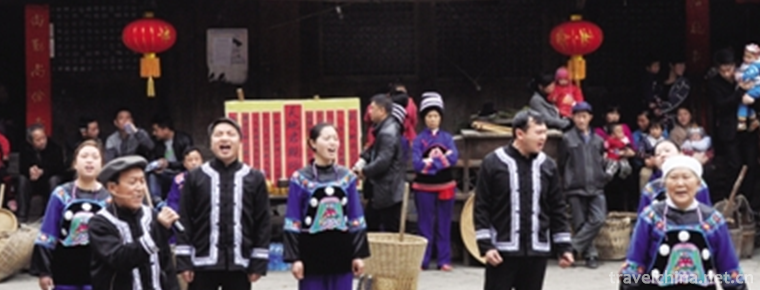
-
Town God TempleChenghuang Temple
Located in Shanghai's Huangpu District Fang Bang Road.
Views: 153 Time 2018-10-12 -
Buyi Chabai Song Festival
The Buyi Chabaige Festival is a commemorative festival of the Buyi people in Xingyi, southwest Guizhou Province. It is held in Chabaichang, Dingxiao Town, Xingyi City.
Views: 152 Time 2019-04-04 -
Bouyei Pange
Bouyei Pange is a traditional folk song of the Bouyei nationality. It is a folk literary work created and sung in the original Bouyei language. Bouyei Pange is popular in Buyi villages.
Views: 117 Time 2019-04-04 -
Fuzhou bodiless lacquerware decoration skills
Fuzhou bodiless lacquerware decoration technology, Fuzhou, Fujian Province, local traditional handicraft, one of the national intangible cultural heritage..
Views: 173 Time 2019-04-30 -
Construction Techniques of Li Nationalitys Ship type House
The carrier of the excellent architectural skills of the Li nationality will inevitably fade out of sight in the fierce collision between traditional civilization and modern civilization. Today only a.
Views: 261 Time 2019-05-12 -
Liaoning wind and percussion ensemble
Liaoning drum music, commonly known as drum music. It is one of the traditional folk instrumental music in China. Liaoning drum music is divided into Suona music and Sheng wind music, and according to.
Views: 283 Time 2019-05-13 -
Drum dance
Hani rhythm and drum dance is a kind of sacrificial dance of Hani people on the traditional festival "Onmatu". The dance is vigorous and bold, vigorous, simple and free, showing the same per.
Views: 53 Time 2019-05-23 -
Shaoxing opera
Shao Opera, a traditional Chinese opera. Originally known as "Shaoxing Chaotian Bomb", commonly known as "Shaoxing Daban", it originated from Qin Opera and was named Shaoxing Opera.
Views: 183 Time 2019-06-14 -
Yangge Opera
Yangge Opera is a traditional opera art widely popular in China, mainly distributed in Shanxi, Hebei, Shaanxi, Inner Mongolia, Shandong and other places. It originated from the songs sung by the worki.
Views: 208 Time 2019-07-10 -
Jumping vegetables of the Yi nationality
The dance accompaniment of the Yi nationality is "Dance dishes", which means serving dishes by dancing. It is a unique form of serving and the highest etiquette of banquet for Yi people in W.
Views: 148 Time 2019-07-12 -
Guangyuan secondary industry
In 2018, the total industrial added value of Guangyuan was 30.018 billion yuan, an increase of 9.4% over the previous year. The contribution rate of industry to economic growth is 44.3%, which drives economic growth by 3.7 percentage points..
Views: 330 Time 2020-12-15 -
Plant resources in Neijiang
Neijiang City is a subtropical evergreen broad-leaved forest belt with mild climate and abundant rainfall, which is suitable for the growth of a variety of trees. There are more than 60 subjects, 110 genera and 190 species. Neijiang is mainly composed of timber forest.
Views: 304 Time 2020-12-16
